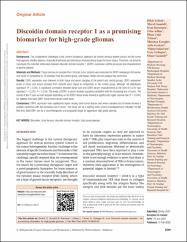| dc.contributor.author | Erdem, Dilek | |
| dc.contributor.author | Günaldi, Meral | |
| dc.contributor.author | Karaman, İrem | |
| dc.contributor.author | Yılmaz, İlhan Ümit | |
| dc.contributor.author | Eseoğlu, Metehan | |
| dc.contributor.author | Avcıkurt, Ayla | |
| dc.contributor.author | Işıksaçan, Nilgün | |
| dc.contributor.author | Erdoğan, Uzay | |
| dc.contributor.author | Günaldı, Ömür | |
| dc.date.accessioned | 2024-09-30T10:06:33Z | |
| dc.date.available | 2024-09-30T10:06:33Z | |
| dc.date.issued | 2023 | en_US |
| dc.identifier.issn | 0973 - 1482 | |
| dc.identifier.uri | https://doi.org/10.4103/jcrt.jcrt_708_21 | |
| dc.identifier.uri | https://hdl.handle.net/20.500.12462/15239 | |
| dc.description | Adilay, Utku (Balikesir Author) | en_US |
| dc.description.abstract | Background: Two fundamental challenges in the current therapeutic approach for central nervous system tumors are the tumor
heterogeneity and the absence of specific treatments and biomarkers that selectively target the tumor tissue. Therefore, we aimed to
investigate the potential relationship between discoidin domain receptor 1 (DDR1) expression and the prognosis and characteristics
of glioma patients.
Materials and Methods: Tissue and serum samples from 34 brain tumor patients were evaluated for DDR1 messenger ribonucleic
acid levels in comparison to 10 samples from the control group, and Kaplan–Meier survival analysis has performed.
Results: DDR1 expression was observed in both tissue and serum samples of the patient and control groups. DDR1 expression
levels in tissue and serum samples from patients were higher in comparison to the control group, although not statistically
significant (P > 0.05). A significant correlation between tumor size and DDR1 serum measurements at the level of 0.370 was
reported (r = 0.370; P = 0.034). The levels of DDR1 in serum showed a positive correlation with the increasing size of tumor. The
results of the 5‑year survival analysis depending on the DDR1 tissue levels showed a significantly higher survival rate (P = 0.041)
for patients who have DDR1 tissue levels above cutoff value.
Conclusions: DDR1 expression was significantly higher among brain tumor tissues and serum samples and its levels showed a
positive correlation with the increased size of tumor. This study can be a starting point, since it investigated and indicated, for the
first time, that DDR1 can be a novel therapeutic and prognostic target for aggressive high‑grade gliomas. | en_US |
| dc.language.iso | eng | en_US |
| dc.publisher | Wolters Kluwer Medknow Publications | en_US |
| dc.relation.isversionof | 10.4103/jcrt.jcrt_708_21 | en_US |
| dc.rights | info:eu-repo/semantics/openAccess | en_US |
| dc.subject | Biomarker | en_US |
| dc.subject | Brain Tumors | en_US |
| dc.subject | Discoidin Domain Receptor | en_US |
| dc.subject | High Grade Gliomas | en_US |
| dc.title | Discoidin domain receptor 1 as a promising biomarker for high-grade gliomas | en_US |
| dc.type | article | en_US |
| dc.relation.journal | Journal of Cancer Research and Therapeutics | en_US |
| dc.contributor.department | Tıp Fakültesi | en_US |
| dc.identifier.volume | 19 | en_US |
| dc.identifier.issue | 8 | en_US |
| dc.identifier.startpage | S285 | en_US |
| dc.identifier.endpage | S293 | en_US |
| dc.relation.publicationcategory | Makale - Uluslararası Hakemli Dergi - Kurum Öğretim Elemanı | en_US |


















